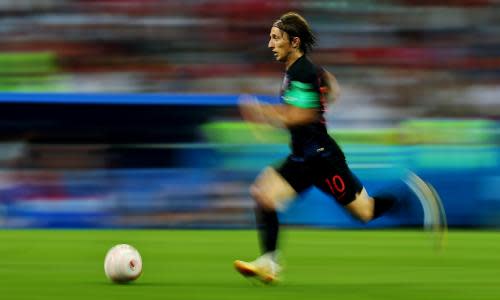Croatia scouting report: Luka Modric the key man but set-piece flaws abide
Set-piece frailties could play into England’s hands
Luka Modric flagged up a weakness for Croatia without being asked. “We watched the [England] game today, we saw how good they are from dead-ball situations. We have to improve that element of our game.” Freeze-frame Russia’s late equaliser from a free-kick and it is alarming just how much space Croatia gave their opponents. Seven of the 10 Croatia players in the area took up extremely deep starting positions, almost on the edge of the six-yard box. Just as significantly, none of them were “touch-tight” on any of the Russian players.
Whether that was because they were marking zonally, concerned about being penalised for holding or simply too exhausted to think straight at the end of a long evening is unclear. But it was ridiculously easy for the unmarked Mário Fernandes to head home. And that is not an isolated case. A long throw against Denmark, in the previous round, led to Mathias Jørgensen’s goal. Iceland also had some joy against Croatia via set-pieces – Sverrir Ingason headed against the bar when he should have scored and long throws caused consternation again. It is hard to avoid the conclusion that Dejan Lovren and Domagoj Vida, the two central defenders, are not commanding enough when attacking balls in their own area.
That said, Vida did manage to score at the other end against Russia, so there is a cautionary footnote here for England. Nonetheless, with five of England’s 11 World Cup goals having come from corners or free-kicks, Gareth Southgate’s players should be encouraged.
READ MORE: England celebrates Gareth Southgate as hero of World Cup
READ MORE: Woodburn wanted by Championship duo as Klopp considers loaning Welsh star
READ MORE: Barcelona midfielder Paulinho returns to Chinese Super League
Neglectful Perisic leaves left flank exposed
Ivan Strinic, Croatia’s left‑back, has long been the national team’s scapegoat. “I’ve learned how to deal with it,” the Sampdoria defender said recently, fully aware the finger of blame is generally pointed in his direction whenever things go wrong. Whether that is fair or not, it was clear that Russia targeted Strinic. Russia had plenty of joy on their right flank, where Fernandes, galloping forward from full-back, and Alexander Samedov, the wide man in front of him, caused no end of problems during the first half.
Zlatko Dalic, Croatia’s coach, acknowledged that was the case afterwards and talked about there being “quite a lot of pressure” from Fernandes, who breaks from deep in a similar way to Kieran Trippier.Strinic picked up a yellow card for a cynical tug on Samedov and was later withdrawn, perhaps with that caution in mind, yet he will almost certainly start against England. In fairness to the 30-year-old, who has won 47 caps, there were some mitigating circumstances against Russia. Ivan Perisic, who started wide on the left and was also substituted, provides little defensive protection and often left the -back outnumbered. Trippier, working in tandem with one of Jesse Lingard, Dele Alli and Raheem Sterling, must look to create overloads on England’s right.
Rakitic and Modric can orchestrate with style
One plays for Real Madrid, the other for Barcelona, which is not a bad starting point. Aged 30 and 32, Ivan Rakitic and Modric are in now‑or-never territory for Croatia. They are playing like they realise that, too.
Croatia have controlled possession in four of their five matches, peaking with 65% against Russia, and that is largely down to the influence of Rakitic and Modric. The only game where Croatia saw less of the ball than their opponents was against Argentina. On that occasion, Croatia won 3-0.
The one dilemma for Dalic is how to configure his midfield to maximise Modric’s talent. When he took over last year, Dalic thrust Modric further forward, into the No 10 role, to try to give the team more penetration, and it worked. Against Russia, however, Dalic reverted to tactics more often deployed by his predecessors – and not always with success – as Modric initially sat deeper, alongside Rakitic, in order to accommodate an extra attacker. Croatia were overrun for 45 minutes. “We lacked a body in midfield,” Dalic admitted. The Croatia coach introduced Marcelo Brozovic as a screening midfielder, to liberate Modric and Rakitic, and his team controlled the game thereafter. That 4-3-3 or 4-1-4-1 formation, depending on how you interpret it, is likely to be how Croatia will set up against England, giving Southgate a conundrum of his own, because Jordan Henderson will, without question, need help in midfield to prevent Modric and Rakitic from running the show.
A first serious test for England’s defence?
With Belgium playing their reserves against England, Colombia missing James Rodríguez and Sweden’s attack led by a striker who failed to score at this World Cup, there is an argument that Southgate’s three/five-man defence has yet to be really tested in Russia. That is not to take any credit away from the way that Harry Maguire et al have performed so far, just a reminder the bar will be raised in Moscow on Wednesday. Although Croatia are not blessed with the attacking prowess of Belgium or France, Dalic still has talented individuals at his disposal, and each brings something different to the team. Andrej Kramaric, who can play anywhere across the front, is a far better player than he showed at Leicester City. The selfless Mario Mandzukic will run himself into the ground. Perisic, who was close to joining Manchester United last summer, provides craft and guile on the left, and Ante Rebic is pacy and direct. All four started against Russia. Dalic will not go down that path again because of the space they conceded in midfield, but England will be stretched regardless, especially in the wide areas behind Trippier and Ashley Young.




